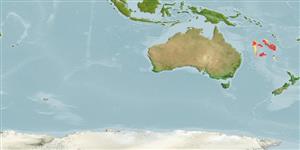Ikan bertulang rawan (sharks and rays) >
Myliobatiformes (Stingrays) >
Urolophidae (Round rays)
Etymology: Urolophus: Greek, oura = tail + Greek, lophos = crest (Ref. 45335); neocaledoniensis: neocaledniensis because of its apparent abundant and widely distributed occurrence in the New Caledonian region (Ref. 51067).
More on authors: Séret & Last.
Environment: milieu / climate zone / depth range / distribution range
Ekologi
laut batidemersal; kisaran kedalaman 229 - 428 m (Ref. 51067). Deep-water; 17°S - 29°S, 157°E - 168°E
Western Central Pacific: New Caledonia (including the Chesterfield Islands) and the northern part of the Norfolk Ridge.
Length at first maturity / Size / Weight / umur
Maturity: Lm ?, range 30 - ? cm
Max length : 36.6 cm TL jantan/; (Ref. 51067)
deskripsi pendek
Kunci identifiaksi (pengenalan) | Morfologi | Morfometrik
Duri punggung (Keseluruhan (total)) : 0; vertebrata, bertulang belakang: 144 - 153. Subcircular disc, width less than 70% total length; medium head (ventral length exceeding 30% total length) and snout (length to eye less than about 16% total length); broad, cartilaginous interorbit exceeding 4% total length; internasal flap skirt-shaped, diverging slightly; no broad lobes on posterolateral border of nostrils; inner margin of spiracle oblique; lateral tail folds absent or rudimentary; no dorsal fin; apices of pelvic fins rounded; 7-10 oral papillae along a 'W' line on mouth floor; 95-102 pectoral fin radials; total vertebrae rarely exceeding 150; dorsal surface greyish brown (Ref. 51067).
Inhabits the continental slope (Ref. 51067).
Life cycle and mating behavior
Kematangan | Reproduksi, perkembang biakan | Pemijahan | telur-telur | Fecundity | Larva
Séret, B. and P. Last, 2003. Description of four new stingarees of the genus Urolophus (Batoidea: Urolophidae) from the Coral Sea, South-West Pacific. Cybium 27(4):307-320. (Ref. 51067)
Status IUCN Red List (Ref. 130435: Version 2024-2)
ancaman kepada manusia
Harmless
penggunaan manusia
Alat, peralatan
laporan khas
muat turun XML
Sumber internet
Estimates based on models
Preferred temperature (Ref.
123201): 15 - 18.6, mean 17.2 °C (based on 4 cells).
Phylogenetic diversity index (Ref.
82804): PD
50 = 0.5000 [Uniqueness, from 0.5 = low to 2.0 = high].
Bayesian length-weight: a=0.00813 (0.00372 - 0.01775), b=3.08 (2.88 - 3.28), in cm total length, based on LWR estimates for this (Sub)family-body shape (Ref.
93245).
Trophic level (Ref.
69278): 3.5 ±0.4 se; based on size and trophs of closest relatives
Daya lenting (Ref.
120179): Rendah, Waktu penggandaan populasi minimum 4.5 - 14 tahun (Assuming fecundity<100).
Fishing Vulnerability (Ref.
59153): Low to moderate vulnerability (27 of 100).
